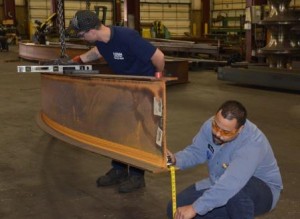Quality is the essential aspect of all services rollers/benders provide. The simple definition of quality is conformance to the customer’s specifications. In the case of curved steel sections, the dimensions specified would typically be on detailed fabrication drawings. The drawings typically have the material type, the section type, the orientation, radius, degree of arc, and if there are any tangents. Correctly detailed drawings have quality tolerances given on the drawings. The tolerances come from the Code of Standard Practice for Steel Buildings and Bridges (COSP) prepared by the American Institute of Steel Construction. This code provides a useful framework for a common understanding for the acceptable standards when contracting for structural steel. The COSP tolerances do not apply to benders/rollers, however, but rather to the fabricators whose projects incorporate this steel. The standards apply to the curved sections after they have been fully fabricated, e.g. cut to length, welded, and painted. For curving purposes benders/rollers curve a section to the specified radius tolerances on the drawings so it is easier for the fabricator to fabricate to the specified radius.
To assure quality, the machine operator conducts visual inspections of material for conformance with the designed specifications for the curved/bent steel material used. Sometimes the machine operator will have a helper who aids in the rolling inspection by also checking dimensional accuracy, smoothness of the curves, and correct product completion. To verify the radius is correct, the operator will use a radius template and/or chord and rise technique.

Many Original Equipment Manufacturers (OEMs) provide their vendors with a quality scorecard indicating the percentage of parts received that met their quality standards. Most benders/rollers maintain a comprehensive quality management system to guide their efforts. Corrective Action Reports (CAR’s) measure the number and cost of non-conforming parts and determine the root cause of the problems. An analysis of the source of the problem leads to its elimination. To eliminate the problem and to maintain the specified quality, one must invest in training, equipment and technology.
[maxbutton id=”1″]







